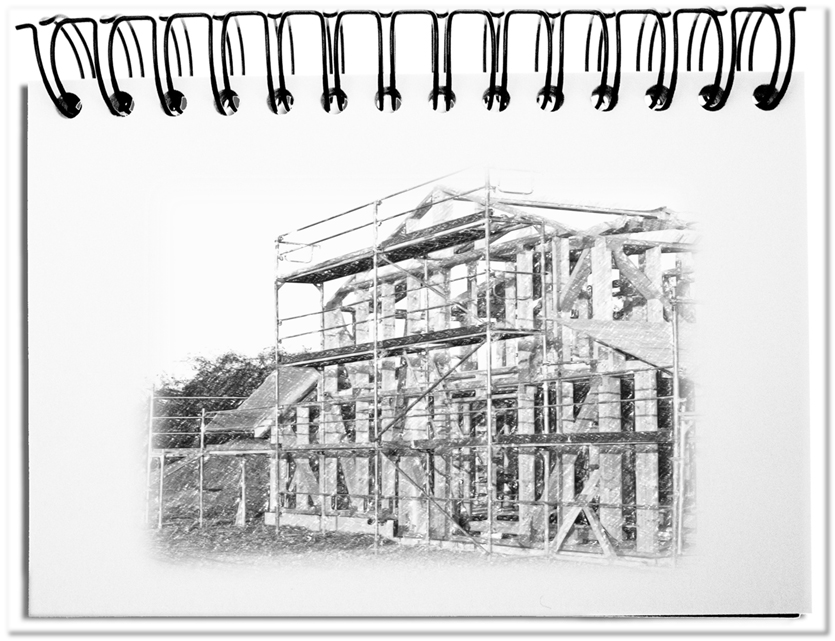The longest project experience gained mankind with the building of its accommodations. After the available caves were occupied and people went on journey, 100,000 years ago, all have built ever more frequently a hideout. With the extension of businesses from hunters and gatherers to farmers and herders, these dwellings became more and more stable and complex in the last 10,000 years. Building houses became a profession that developed since then more and more know-how and forms. Thus the building of houses with its procedures is a basic experience of us, the ideal metaphor for a project.
In the past twenty years the processing of projects was standardized within all areas. Nevertheless two thirds of the projects (see here: http://ow.ly/zy5hB ) still fail. In order to provide a feeling of normal completion to the participants, the building of houses offers the structure for the procedures, dependences, interim results and restrictions that can be transferred to all kinds of projects with its construction phases.
- Preparation
The building of houses also begins a long time before the groundbreaking. The question arises, how the own four walls should look like – a house, a Penthouse, an apartment, old or new building. An important condition is the location – in the country, in the city suburb or in the city center. All of this leads to the question whether you can afford the new haven at all.
Business projects have to worry about similar questions. Making or buying the solution? How does the existing infrastructure look like? How large is the available budget? Who is the ideal project partner? Here again the substantial conditions have to be compiled, before the project is approved at all. For the sake of simplicity, we take a look at an IT-project hereinafter. - Plan
After the official commissioning the real planning begins. Rough ideas are now exchanged between the owner and the architect as well as the other craftsmen. More serious conceptions of the result evolve. A more precise calculation of the costs and dates is now possible. IT-projects could be estimated more exactly before the start. Due to the general backlog of developments the participants save the expenditure and only start with real estimations, when the project officially begins. Now the original estimations can be adapted. Is there not enough budget and time at a closer look, it is now the last possibility to stop the project without large losses. With the next phase genuine construction costs arise. - Shell construction
The permanent peer pressure of the clients produces unrealistic milestones. With the house building it is regulated by a certain procedure. The foundation has been laid before the walls can be built. The roof can only be raised, after all floors are finished below. Crucial milestone is the roofing ceremony, because the shell construction is done.
The software development has similar restrictions. Nevertheless the IT-specialists tend to work excessively in parallel. This results frequently in the fact that modules have to be changed or programmed from scratch afterwards. Contrary to the house building, with its roofing ceremony, there is not a respective milestone in IT. The participants have difficulties to find an end and change and change… - Interior fittings
At latest in this section all participants notice, how the final results will look like. The size of the rooms and the windows, the course of the stairs, the entrances, the distances to the adjoining property, etc. From now on changes can only be made within the finished frame – putting a wall here or pulling out a non-load-bearing wall. With the interior fittings completely new players are added, who must be introduced. A fuzzy planning of their tasks can extend the entire schedule with its already existing delays additionally.
Similarly the development of the user interface and the final definition of formulas and reports are running. Each fundamental change penetrates the already finished parts and does not only bring additional time delays, but also new sources for errors. - Moving in
The moving in is the last logistic challenge. Furniture must be brought intact into the house and do not immediately ruin, if possible, the newly built house. Now you will see whether all measurements are correct and that there is sufficient space. Does the kitchen fit? Is there enough space around the bed? Is the cellar large enough?
With the respective Go-live of software the application begins for the real users. The software has to function from now on under real operative conditions. The less the users were prepared with trainings and tests, the more probable are difficulties, which have to be repaired during operation. This is the end of the actual project – however IT-projects mostly do not finish here, since from now on you improve, and improve, – until the next version.
Bottom line: The house building is the ideal metaphor for a project, since it shows the dependencies of work packages. The basic steps become visible, like e.g. the upstream decision with its extensive consequences, the planning that secures the smooth operation, the structure of the shell construction that creates the framework for the later contents, the final arrangement of the details and eventually the hand-over to operations. Several thousand years of experience are conveyed by this metaphor and to facilitate the alignment.

